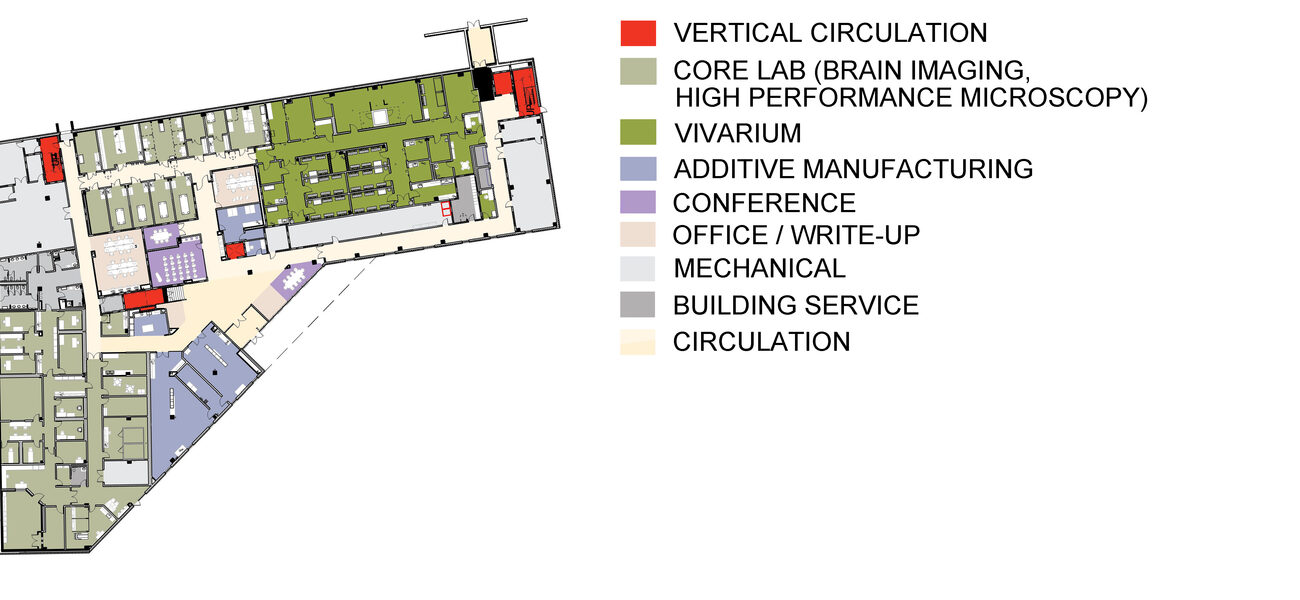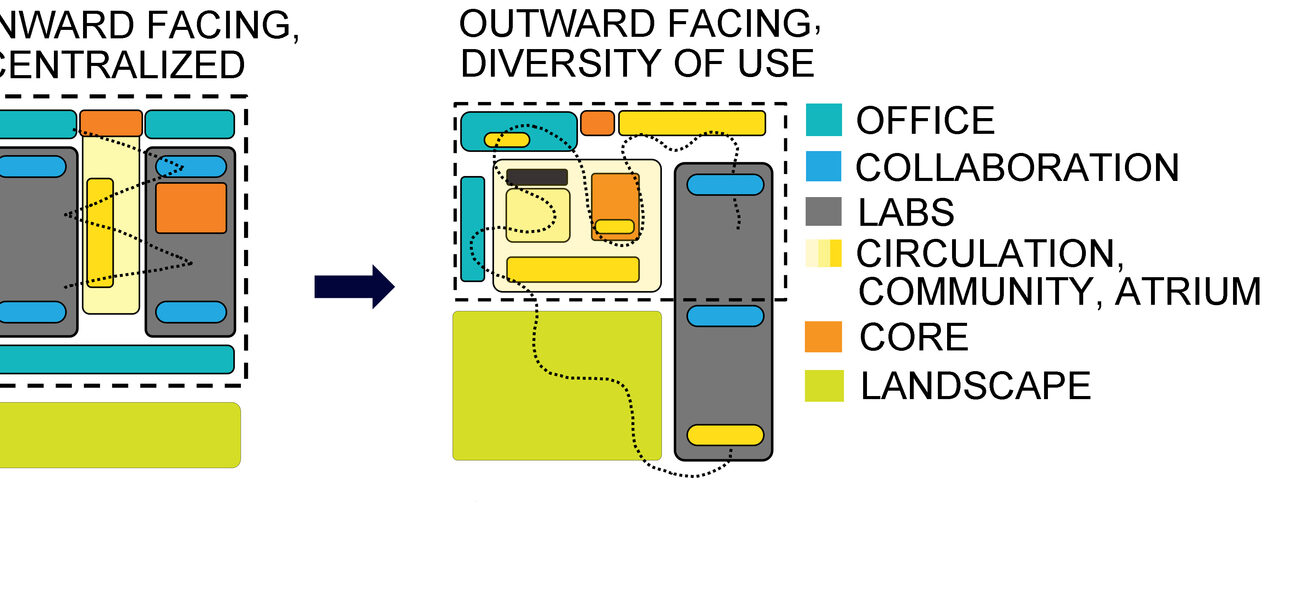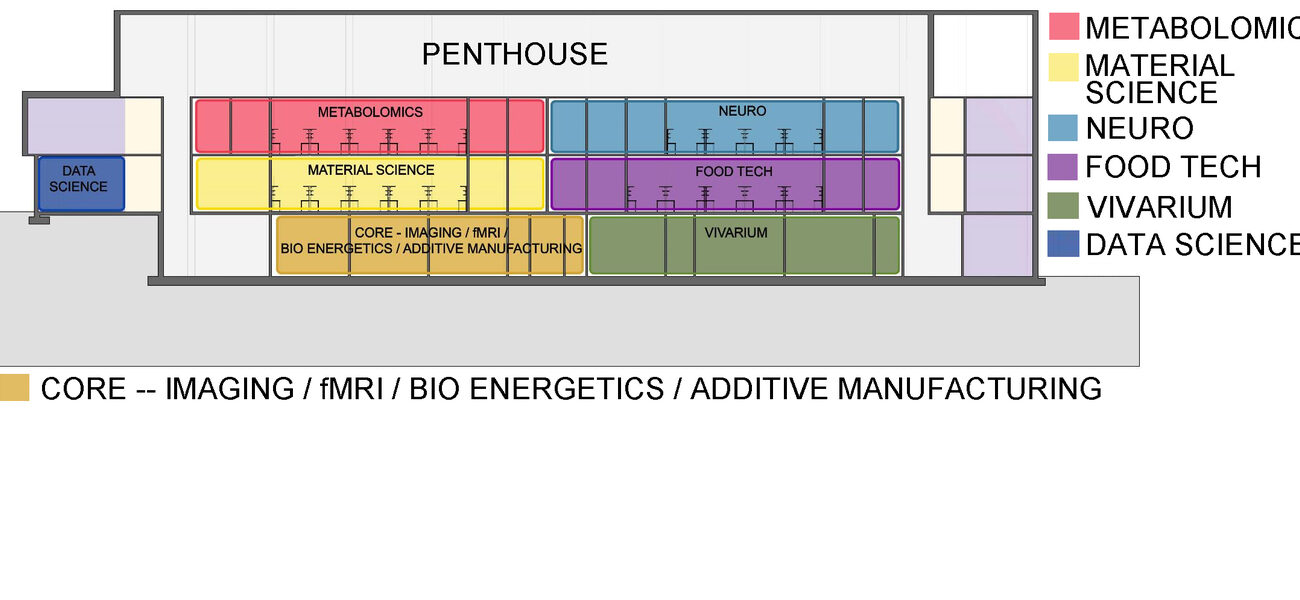College campuses are great for what they are—places to bring students and faculty together in the cause of learning and research. Today, though, universities are increasingly seeking to bring in private industry to take advantage of research synergies and help build the next generation of innovations. New science building projects and renovations need to invite and encourage corporate teams as well as establish fruitful grounds for discoveries. The University of Arkansas faced this challenge when contemplating a new building— the Institute for Integrative and Innovative Research, nicknamed I3R—to house labs, core facilities and office space to support five research centers of excellence. They sought to convey an inviting image and a less ivy-covered appeal, starting with the location on the Fayetteville campus.
“We narrowed it down to two choices, one on the periphery of campus, one in the research park,” says Wesley Stites, associate vice chancellor for research at the university. “You’re balancing ease of access for the external versus the internal audience.”
Working with the team at HGA and architect of record, Hufft, the university decided the on-campus location offered the best balance. “A lot of people thought that being on campus would be attractive to some industrial partners. A lot of people like hanging out at colleges,” says Stites.
The location selection process included considering what corporate partners expect from a physical building. “If the project has its genesis at a university, you want to locate the building so it’s accessible to outside partners,” says Jeffrey Puleo, planning principal at HGA. “Make sure the amenities draw external partners in, with things as simple as parking and food, hoteling space where someone can come in and feel welcomed and feel like they belong for the day, week, or a month.”
“We’re on the periphery of campus, right across the street from a parking deck. If you’re just coming in for a short period of time, it’s not a trek,” says Stites.
Along with amenities, they sought to give the building—which is still under construction—an up-to-date appearance, so the “look and feel of the building architecturally started to divorce itself from the traditional brick and limestone campus aesthetic that’s across the street,” says Puleo.
“Innovation Valley of Death”
Designing for collaboration isn’t just about looks or about corporate and research people meeting at the coffee machine. It’s intended to smooth out the process of turning researchers’ discoveries into marketable products—a process that often gets bogged down in what Stites calls the “innovation valley of death.”
Besides creating inviting spaces, today’s research buildings also need to encourage real collaboration and information exchange. Strategically locating core facilities—vivaria, imaging, high-end microscopes—can bring research teams together and foster organic connectivity.
“It is all about these converging networks, across campuses and beyond, with a corporate culture, corporate sponsorship for research, corporate identity, corporations leveraging academic institutions for research talent,” says Puleo.
This is the latest step in an evolution that has been going on for decades, of course. Gone are the days when a lab was fixed in space and layout. Modular designs are common in many institutions, allowing labs to grow, shrink, or change focus depending on the organization’s needs. Technological leaps and interdisciplinary projects have helped foster the core facilities model, where smaller individual labs take advantage of equipment and services that are available to many scientists and departments instead of just one.
The Life Science Laboratories building at the University of Massachusetts Amherst is an example of a design that combines academic and industry approaches, with core facilities incorporated into a curved structure with modular space for 10 principal investigators per floor, each with a team of eight to 10 people.
“They developed core labs to support the end products. This is where the corporations started to come into the picture at the university and participate in the research,” says Puleo. “We have the faculty generating the ideas, and corporations seated in the building who are funding the research, which is not your traditional federal funding mechanism.”
Another example is the Health | Science | Technology building at Lehigh University in Pennsylvania, where speed-to-market, customer engagement, and measurable outcomes were among the project drivers defined for the structure before work began. “The idea was to build that module on functionality: Don’t set it up for chemistry and biology and dry work—let’s set up a ballroom lab that runs a spectrum of research capability from the wet to the damp,” says Puleo.
This open space clusters biological processes at one end and materials processes at the other, with mobile benches in between that can be rearranged as projects and needs change. “It was an engineering challenge. But when the engineers embraced that modular cadence of systems and ductwork and power densities, it started to come off fairly seamlessly,” says Puleo.
More than ever, the Lehigh project seeks to pull specific functions out of individual labs and make them into core services. “Everybody is participating in tissue culture, microscopy, cold, warm, and laser labs—things that we haven’t seen set up as cores in the past,” says Puleo. Office spaces emphasize collaboration and removing artificial barriers between faculty and students.
Broad Topic Clusters
The I3R building, funded in part with a $194.7 million grant from the Walton Family Charitable Support Foundation, is located near many major retail, logistics, food, and industrial companies—a prime site for building bridges between the corporate and academic worlds. Achieving this, however, will mean changing many of the ways universities are used to doing things.
“We are going to have to come up with a new governance structure for this building that helps us deal with those issues,” explains Stites. “It is going to be reporting to the vice chancellor for research, not to a dean or to a department. And we are going to have to think about the way we are going to engage industry. Also, a big goal for the gift is a regional transformation, not just the institution. We are not going to make our donor happy if we don’t achieve some dramatic changes in the economic landscape of the region.”
Inside, the building seeks to maximize opportunities for serendipitous innovation. “Let’s look at the different groups that come in to innovate or formulate; let’s overlap them by technology and not business unit or department, and allow them to bump into each other to innovate,” says Peter Balistrieri, a principal at HGA. “I always make this goofy joke about Reese’s Peanut Butter Cups. I’m glad peanut butter and chocolate bumped into each other. This is the foundation of that idea.”
“Neighborhoods” in many new corporate and academic buildings aren’t limited to research space. For example, in a corporate environment, finance, marketing, and sales teams could be adjacent as they are part of a product development continuum and share ideas. Flexibility remains a key value, allowing departments to take up more or less space as circumstances dictate. “Because when a product hits big, that group is going to balloon and it is going to start squeezing out other groups that are in the building,” says Balistrieri.
Instead of traditional departments or individual researchers’ labs, the new building features “innovation clusters” in five topic areas: food systems, metabolic disease, data science / data analytics, neuroscience, and materials science. “These don’t just span departments; they span multiple colleges, each one of these,” says Stites. “Plus, we want to foster collaboration and innovation between these innovation clusters, which is a pretty high bar to meet.”
Identifying industry as the institute’s “customer,” Stites says the building’s “brand” is specifically regional as well as modern. Arkansas steel and timber are significant in the design, and the research and industrial nexus is visible from first setting foot inside, where the visitor gets a view of a large, open, glassed-in makerspace.
The ground floor will be devoted to core facilities accessible to all the subject-area clusters and to private sector partners. Human subjects research, for example, is concentrated in one part of the building to promote efficiency in shared spaces like reception and waiting areas, but deliberately mixes researchers from neuroscience, food systems, metabolic diseases, and material science to generate synergies and new research collaborations.
The second floor will be home to two clusters—neurosciences and metabolic science, two subject areas that have some natural overlap. “We have these open lab spaces with a support function in between, but we expect and hope that, in the long run, we’ll end up assigning people from both groups in both ballroom spaces to try to deliberately mix them up and get them interacting with one another in ways that we wouldn’t otherwise have,” says Stites.
The commitment to flexibility and innovation is crucial to achieving the institute’s goals of regional transformation and corporate engagement, says Puleo. “We look to encourage our clients to think a little more broadly than the traditional siloed approach.
By Patricia Washburn


